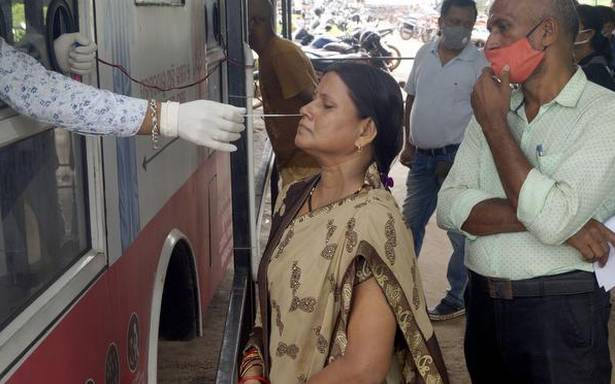The Health Ministry said it was forcefully underlined that any laxity at this stage will result in the deterioration of the situation in these districts
Districts reporting a COVID-19 positivity rate of over 10% in the last few weeks need to consider strict restrictions to prevent or curtail people’s movement and crowding, the Centre told 10 States witnessing an upsurge in infections and positivity.
Highlighting that 46 districts are showing more than 10% positivity rate while another 53 are showing positivity between five and 10%, the Centre has urged the states to ramp up their testing for detection of COVID-19.
The Health Ministry said it was forcefully underlined that any laxity at this stage will result in the deterioration of the situation in these districts.
Union Health Secretary Rajesh Bhushan chaired a high-level meeting on Saturday to review the COVID-19 situation in Kerala, Maharashtra, Karnataka, Tamil Nadu, Odisha, Assam, Mizoram, Meghalaya, Andhra Pradesh and Manipur.
The public health measures taken for surveillance, containment and management of COVID-19 by the health authorities in these states were also reviewed. These states are either reporting a rise in daily Covid cases or a rise in positivity.
The Health Ministry, in a statement, said, "All districts reporting positivity rate of more than 10% in the last few weeks need to consider strict restrictions to prevent/curtail the movement of people, formation of crowds and intermingling of people to prevent the spread of infection." Noting that more than 80% of active cases in these States are reported to be in home isolation, it said there is a need to effectively and strictly monitor these cases so that they do not meet other people and spread the infection.
"The people in home isolation should be effectively monitored in such a manner to ensure that those who require hospitalization are seamlessly transferred for timely clinical treatment.”
"Detailed standard operating procedure covering various facets of effective clinical management of COVID-19 patients in hospitals have been earlier shared with the states for prompt shifting and effective hospital management," the Centre told States.
The ministry also asked states to focus on those districts where the positivity rate is less than 10%, so as to protect these districts and the populations by focusing on saturation of vaccination there.
"States were again informed that this quantum of vaccine doses indicates the minimum possible allocation by the Centre to the states; quantum more than this is usually delivered by the Union Health Ministry to states based on their consumption," the statement said.
The ministry said the states were advised to direct private hospitals to put up hospital-based PSA plants.
"States have been earlier advised regarding this in the past two months. Provisions under the Clinical Establishment Act enable states to issue such direction to private hospitals. For states which have already issued such directions, they were advised to review the status and facilitate the private hospitals further," it said.
The Health Ministry also asked states to conduct their own serosurveys for district-wise disease prevalence data, as such a survey at the national level was heterogeneous in nature.
Indian Council of Medical Research (ICMR) Director General Dr Balram Bhargava advised states to ramp up vaccination in the senior citizens and the 45-60 year categories as evidence show near 80% of the mortalities are from these vulnerable age groups.
About enforcement measures, he advised states to avoid all non-essential travel and discourage large gatherings.
Granular analysis of the highly affected districts in these states, COVID-19 vaccination coverage, the status of ventilators, PSA plants, oxygen cylinders and concentrators along with some key statistics was presented at the meeting.
The Centre also asked states were asked to use the INSACOG laboratory network for genomic surveillance to screen international travellers, monitor ongoing surveillance through sentinel sites (RT-PCR labs or secondary and tertiary care hospitals managing COVID cases) and surge surveillance.
States were advised to undertake intensive containment and active surveillance in clusters reporting higher cases, define containment zones based on mapping of cases and contacts traced and undertake regular reviews and follow-up.
Source: Read Full Article

